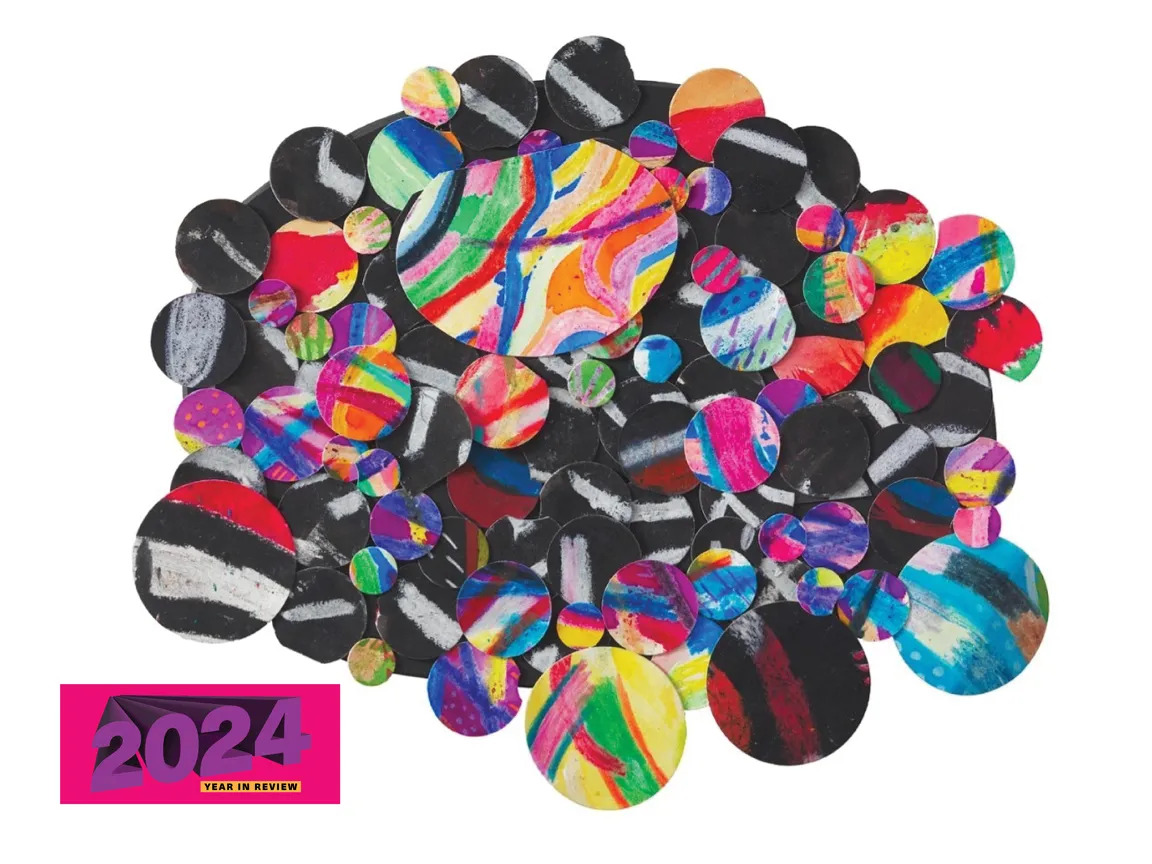
This year, exhibitions around the globe highlighted Blackness, celebrating the Black artistic vanguard and featuring established artists next to those early in their careers. From Switzerland and Cape Town to Fort Worth and Philadelphia, they walked us through the Black art-historical canon, providing context and inserting new characters into modern and contemporary art histories. By exhibiting the range and diversity of Blackness as narrative in a variety of forms, from collage to figuration to video and installation, these shows helped us understand that Blackness is not a monolith. Looking closely at Black art in this way develops scholarship and aptly recognizes the contributions of Black art to the larger canon, positioning it prominently on the world stage.
-
“The Time Is Always Now: Artists Reframe the Black Figure”

Image Credit: Sarah Croop/Philadelphia Museum of Art. The title for this exhibition comes from a James Baldwin quote, “There is never a time in the future in which we will work out our salvation. The challenge is in the moment, the time is always now.” The exhibition, currently on view at the Philadelphia Museum of Art (through February 9, 2025), aims to depict the richness of Black contemporary life through a visual art lens. With more than 60 contemporary works by 22 British and American artists including Amy Sherald, Michael Armitage, and Claudette Johnson, the show features not portraiture but figuration. Its title recognizes the urgency of art right now and how it is impacting both the contemporary moment and the future of the canon. The exhibition was initially exhibited at the National Portrait Gallery in London.
-
“Giants: Art from the Dean Collection of Swizz Beatz and Alicia Keys”

Image Credit: Nykieria Chaney/Getty Images. Met with much fanfare, “Giants,” on view in Atlanta at the High Museum of art through January 19, 2025, highlights the work of some of contemporary art’s most iconic practitioners as Swizz Beatz (Kasseem Dean) and Alicia Keys, stars in their own right as musicians, share artwork from their collection. The 98 pieces represent 37 artists from the United States as well as Europe and Africa. The majority are large in scale, so the title of the exhibition refers not only to the magnitude of the featured artists’ vision but also to the size of the artworks themselves. Included are paintings by art stars like Nina Chanel Abney, Titus Kaphar, and Kehinde Wiley and a generous contribution of photographs by Gordon Parks, Deana Lawson, and Jamel Shabazz. The show was initially exhibited at the Brooklyn Museum of Art.
-
“Multiplicity: Blackness in Contemporary American Collage”

Image Credit: Frist Art Museum, Nashville, Tennessee. As the first exhibition of its kind devoted to collage, “Multiplicity” showed the complex nature of Black identity through 80 artworks by 52 intergenerational artists. Addressing historical and contemporary issues concerning Black life, the artists stepped beyond restrictive boundaries and surpassed the general notion of collage as glued paper by using a variety of media to create dynamic artworks. As is historically typical of Black survival, these artists gave new life to old materials in the most engaging ways. The exhibition featured known collagists, Wangechi Mutu and Deborah Roberts, but it also surprisingly featured collages by Kerry James Marshall and Radcliffe Bailey. These artworks continue the groundbreaking legacy of collage innovators Picasso, Braque, and Bearden. The exhibition was initially mounted at the Frist Art Museum in Nashville and traveled to the Museum of Fine Arts, Houston, and the Phillips Collection in Washington, D.C.
-
“When We See Us: A Century of Black Figuration in Painting”

Image Credit: Zeitz Museum of Contemporary Art Africa, Capetown, South Africa. The title of this exhibition was taken from the Ava DuVernay miniseries When They See Us, about the wrongful conviction of the Central Park Five. Turning they into we changed the perspective from tragedy to triumph. Instead of colonialism, racism, and violence, the show focused on community, strength, and pleasure. The exhibition included 150 works by 120 artists from Africa and the diaspora, such as Toyin Ojih Odutola, Kehinde Wiley, and Lynette Yiadom-Boakye along with newer names; together they represent a century of artmaking in the negritude, Pan-Africanism, and Black Lives Matter movements. The exhibition touted Black joy as political power and heralded triumph over oppression by finding similar themes from different parts of the world. The exhibition was conceived at the Zeitz Museum of Contemporary Art Africa in Cape Town and traveled to the Kuntsmuseum Basel. Many of the works had never been shown before in Switzerland.
-
“The Harlem Renaissance and Transatlantic Modernism”

Image Credit: AFP via Getty Images. The Metropolitan Museum of Art’s exhibition of artworks from the Harlem Renaissance was the first show of its kind since 1987, when the Studio Museum in Harlem organized “Harlem Renaissance: Art of Black America.” The Met’s last attempt at holding an exhibition about Harlem was not highly regarded. In fact, there were protests surrounding the “Harlem on My Mind” exhibition in 1969 because it barely featured any Harlem-based artists at all. This year’s exhibition was a welcome change that reflected the ethos of the Harlem Renaissance as a cosmopolitan movement ripe with the new energy of Black people migrating from the South to northern, midwestern, and western cities. The 160 works included in the exhibition showed how Black artists were central to the growth of modern art of the 1920s to 1940s as the movement flourished and the art capital shifted from Paris to New York. They also traveled to Europe and intermingled with artists there, even as they existed on the periphery in the United States.
-
“Surrealism and Us: Caribbean and African Diasporic Artists Since 1940”

Image Credit: Modern Art Museum of Fort Worth. With more than 80 artworks from the 1940s to the present day, this exhibition was the first intergenerational show ever dedicated to Caribbean and African diasporic art. Its title was inspired by the essay “1943: Surrealism and Us” by Suzanne Cesaire, artist and wife of Aimé Césaire, one of the founders of the negritude movement. The exhibition featured work by both Suzanne and Aimé as well as Betye Saar, Kara Walker, Eldzier Cortor, Emory Douglas, and Arthur Jafa and included painting, sculpture, drawings, video, and installation. Caribbean Surrealism was led by the Cesaires; in the United States, Romare Bearden and Ted Joans—also represented in the show—worked in the genre past the time of their European counterparts. (Though Surrealism was an artistic movement in Europe during the 1910s and 1920s, the term Afro-Surrealism wasn’t coined until 1974 by Amiri Baraka.) The show was mounted at the Modern Art Museum of Fort Worth.
Read more of our “Year in Review: 2024” coverage here.
“The Time Is Always Now: Artists Reframe the Black Figure”

The title for this exhibition comes from a James Baldwin quote, “There is never a time in the future in which we will work out our salvation. The challenge is in the moment, the time is always now.” The exhibition, currently on view at the Philadelphia Museum of Art (through February 9, 2025), aims to depict the richness of Black contemporary life through a visual art lens. With more than 60 contemporary works by 22 British and American artists including Amy Sherald, Michael Armitage, and Claudette Johnson, the show features not portraiture but figuration. Its title recognizes the urgency of art right now and how it is impacting both the contemporary moment and the future of the canon. The exhibition was initially exhibited at the National Portrait Gallery in London.
“Giants: Art from the Dean Collection of Swizz Beatz and Alicia Keys”

Met with much fanfare, “Giants,” on view in Atlanta at the High Museum of art through January 19, 2025, highlights the work of some of contemporary art’s most iconic practitioners as Swizz Beatz (Kasseem Dean) and Alicia Keys, stars in their own right as musicians, share artwork from their collection. The 98 pieces represent 37 artists from the United States as well as Europe and Africa. The majority are large in scale, so the title of the exhibition refers not only to the magnitude of the featured artists’ vision but also to the size of the artworks themselves. Included are paintings by art stars like Nina Chanel Abney, Titus Kaphar, and Kehinde Wiley and a generous contribution of photographs by Gordon Parks, Deana Lawson, and Jamel Shabazz. The show was initially exhibited at the Brooklyn Museum of Art.
“Multiplicity: Blackness in Contemporary American Collage”

As the first exhibition of its kind devoted to collage, “Multiplicity” showed the complex nature of Black identity through 80 artworks by 52 intergenerational artists. Addressing historical and contemporary issues concerning Black life, the artists stepped beyond restrictive boundaries and surpassed the general notion of collage as glued paper by using a variety of media to create dynamic artworks. As is historically typical of Black survival, these artists gave new life to old materials in the most engaging ways. The exhibition featured known collagists, Wangechi Mutu and Deborah Roberts, but it also surprisingly featured collages by Kerry James Marshall and Radcliffe Bailey. These artworks continue the groundbreaking legacy of collage innovators Picasso, Braque, and Bearden. The exhibition was initially mounted at the Frist Art Museum in Nashville and traveled to the Museum of Fine Arts, Houston, and the Phillips Collection in Washington, D.C.
“When We See Us: A Century of Black Figuration in Painting”

The title of this exhibition was taken from the Ava DuVernay miniseries When They See Us, about the wrongful conviction of the Central Park Five. Turning they into we changed the perspective from tragedy to triumph. Instead of colonialism, racism, and violence, the show focused on community, strength, and pleasure. The exhibition included 150 works by 120 artists from Africa and the diaspora, such as Toyin Ojih Odutola, Kehinde Wiley, and Lynette Yiadom-Boakye along with newer names; together they represent a century of artmaking in the negritude, Pan-Africanism, and Black Lives Matter movements. The exhibition touted Black joy as political power and heralded triumph over oppression by finding similar themes from different parts of the world. The exhibition was conceived at the Zeitz Museum of Contemporary Art Africa in Cape Town and traveled to the Kuntsmuseum Basel. Many of the works had never been shown before in Switzerland.
“The Harlem Renaissance and Transatlantic Modernism”

The Metropolitan Museum of Art’s exhibition of artworks from the Harlem Renaissance was the first show of its kind since 1987, when the Studio Museum in Harlem organized “Harlem Renaissance: Art of Black America.” The Met’s last attempt at holding an exhibition about Harlem was not highly regarded. In fact, there were protests surrounding the “Harlem on My Mind” exhibition in 1969 because it barely featured any Harlem-based artists at all. This year’s exhibition was a welcome change that reflected the ethos of the Harlem Renaissance as a cosmopolitan movement ripe with the new energy of Black people migrating from the South to northern, midwestern, and western cities. The 160 works included in the exhibition showed how Black artists were central to the growth of modern art of the 1920s to 1940s as the movement flourished and the art capital shifted from Paris to New York. They also traveled to Europe and intermingled with artists there, even as they existed on the periphery in the United States.
“Surrealism and Us: Caribbean and African Diasporic Artists Since 1940”

With more than 80 artworks from the 1940s to the present day, this exhibition was the first intergenerational show ever dedicated to Caribbean and African diasporic art. Its title was inspired by the essay “1943: Surrealism and Us” by Suzanne Cesaire, artist and wife of Aimé Césaire, one of the founders of the negritude movement. The exhibition featured work by both Suzanne and Aimé as well as Betye Saar, Kara Walker, Eldzier Cortor, Emory Douglas, and Arthur Jafa and included painting, sculpture, drawings, video, and installation. Caribbean Surrealism was led by the Cesaires; in the United States, Romare Bearden and Ted Joans—also represented in the show—worked in the genre past the time of their European counterparts. (Though Surrealism was an artistic movement in Europe during the 1910s and 1920s, the term Afro-Surrealism wasn’t coined until 1974 by Amiri Baraka.) The show was mounted at the Modern Art Museum of Fort Worth.
Read more of our “Year in Review: 2024” coverage here.

One of the World’s Best Restaurants Is Hitting the Road With a 12-Course Omakase Dinner

Inside Graphic Image and GiGi New York’s Unique Manufacturing Facility

Incogni helps stop scam calls and removes your info from data brokers

Doc Rivers Wants Vegas Expansion—but NBA Cup Hasn’t Moved Needle


